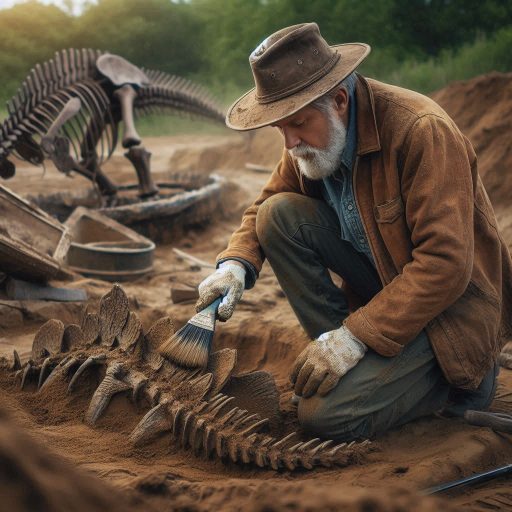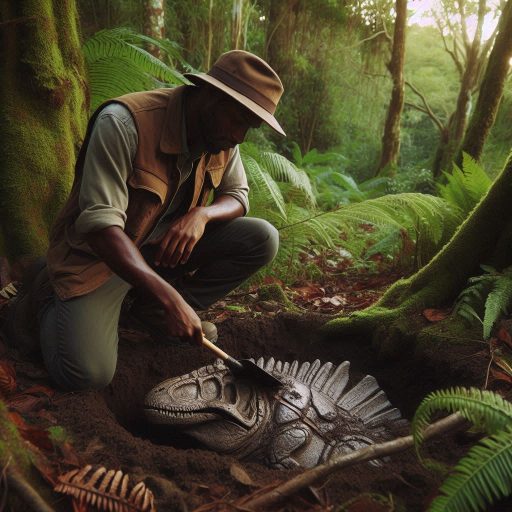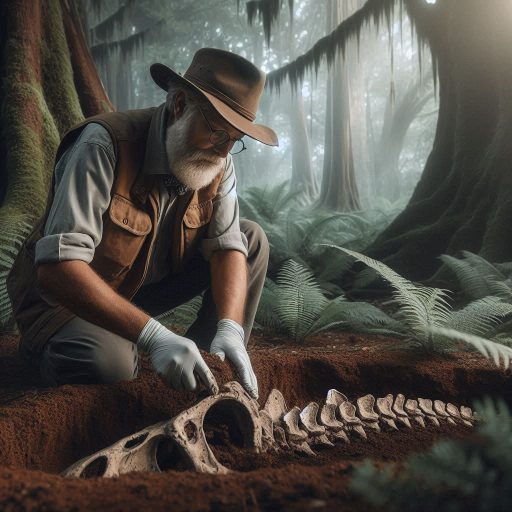Introduction
Paleontological research focuses on studying ancient life through fossil analysis and geological examination.
This field reveals insights into the history of life on Earth.
By employing various tools and techniques, paleontologists gather and analyze data effectively.
Key tools in paleontological research include excavation equipment, brushes, and measuring devices.
These tools help paleontologists carefully extract fossils from rock layers.
Imaging techniques, such as CT scans and X-rays, provide non-destructive ways to study fossils.
These methods allow researchers to visualize internal structures without damaging specimens.
Fieldwork techniques are equally important, as paleontologists document fossil sites and collect samples systematically.
Using geographic information systems (GIS) enhances data analysis and mapping capabilities.
These tools help identify patterns in fossil distribution and environmental conditions.
This blog post aims to highlight the essential tools and techniques that enable successful paleontological research.
Understanding these methods showcases the dedication and precision required in the field.
By exploring the tools used, we can appreciate the complexity of uncovering Earth’s ancient history.
Ultimately, these advancements lead to significant discoveries about our planet‘s past and the evolution of life.
Fossil Excavation
The Process of Fossil Excavation
The process of fossil excavation requires careful planning and execution.
Paleontologists start by selecting a suitable excavation site based on geological surveys.
They assess the area to identify potential fossil-bearing layers.
Once they pinpoint a location, they prepare for a thorough excavation.
Excavation begins with clearing the surface debris.
Paleontologists remove rocks, dirt, and vegetation to reveal the fossil layers.
They often use shovels for this initial clearing, but precision remains vital.
After removing the topsoil, they carefully expose the fossils beneath.
As they uncover fossils, paleontologists work methodically.
They take detailed notes on the location and orientation of each specimen.
This documentation aids in future analysis and research.
The team often employs grid systems to maintain accurate records of fossil positions.
Tools Used in the Excavation Process
Paleontologists rely on various tools to aid in fossil excavation.
Brushes are essential for delicate cleaning, helping to remove dirt without damaging fossils.
They gently sweep away sediment to reveal the details of each specimen.
Shovels assist in removing larger amounts of dirt and rock.
Paleontologists use them for initial clearing but switch to smaller tools as they get closer to fossils.
Precision is critical, as larger tools can damage fragile specimens.
Pickaxes are also common in the excavation process.
They help break apart hard sediment or rock layers that contain fossils.
Paleontologists wield pickaxes carefully to avoid damaging nearby fossils.
Each tool plays a vital role in the successful excavation of fossils.
In addition to these tools, paleontologists often use safety equipment.
Gloves protect hands from sharp rocks and fragile fossils.
Safety goggles shield their eyes from dust and debris during excavation.
Using proper tools and safety gear ensures a safe and effective excavation process.
Importance of Careful Excavation to Preserve Fossils
Careful excavation is crucial for preserving fossils for future study.
Fossils can be delicate, requiring patience and attention to detail.
Rushing the excavation can lead to damage, making it difficult to analyze specimens later.
Preserving the context of fossils is equally important.
The surrounding sediment provides valuable information about the fossil‘s age and environment.
Careful excavation helps maintain this context, which enhances scientific understanding.
Paleontologists often create field jackets from plaster and burlap to protect fossils during transport.
These jackets support fragile specimens and prevent damage.
After excavation, fossils require proper storage and preparation in the laboratory.
In summary, fossil excavation is a meticulous process that demands the right tools and techniques.
Brushes, shovels, and pickaxes play essential roles in this work.
Careful excavation not only preserves fossils but also maintains their scientific context.
By prioritizing precision and care, paleontologists ensure that valuable discoveries contribute to our understanding of prehistoric life.
Fossil Preparation
Steps Involved in Fossil Preparation
The fossil preparation process begins with careful excavation.
Paleontologists carefully remove fossils from their matrix, often using hand tools.
This initial step requires patience to avoid damaging the fossil.
After extraction, the fossil needs thorough cleaning.
Researchers remove dirt and rock using appropriate tools and techniques.
Once cleaned, the fossil undergoes stabilization.
This step is vital for preserving fragile specimens.
Paleontologists often apply consolidants to strengthen the fossil material.
Consolidants help prevent deterioration over time.
Next, researchers document the fossil thoroughly.
They take photographs and record measurements to ensure accurate scientific data.
Finally, the fossil is ready for display or further study.
Proper documentation and preservation techniques enhance the value of the specimen.
Each step in this process plays a crucial role in fossil preparation.
Tools Used in Fossil Preparation
Several specialized tools assist paleontologists in fossil preparation.
Air scribes are among the most common tools used.
These pneumatic devices help remove excess matrix around fossils with precision.
Air scribes allow for detailed work without risking damage to the fossil itself.
Dental picks are also essential in the preparation process.
Paleontologists use these small, pointed tools to carefully chip away at hardened material.
Dental picks help in detailed cleaning and accessing intricate parts of the fossil.
Additionally, soft brushes play a significant role in fossil care.
Researchers use brushes to gently remove dust and debris from fossil surfaces.
These brushes help preserve delicate features while ensuring cleanliness.
Moreover, researchers often use magnifying glasses or microscopes.
These tools aid in examining fine details of fossils during preparation.
Properly equipped with these tools, paleontologists can enhance the quality of their work.
Significance of Proper Preparation
Proper fossil preparation is crucial for accurate research results.
Well-prepared fossils yield reliable data for scientific study.
Any damage during preparation can lead to misinterpretation of findings.
Additionally, accurate preparation enhances the fossil’s longevity.
This longevity ensures that future researchers can study the specimen.
By following meticulous preparation techniques, paleontologists contribute to a wealth of knowledge about ancient life.
Inaccurate preparation can lead to erroneous conclusions about the organism‘s biology or ecology.
Therefore, paleontologists emphasize the importance of thorough preparation in their research.
Proper preparation allows researchers to uncover valuable insights into Earth’s history.
Fossil preparation involves specific steps and specialized tools.
Air scribes, dental picks, and brushes play essential roles in cleaning and stabilizing fossils.
Proper preparation techniques significantly impact the accuracy of paleontological research.
By emphasizing the importance of careful preparation, paleontologists ensure that their findings contribute valuable knowledge to the scientific community.
Read: Continuous Learning: Post-graduate Options for US Biologists
Imaging Techniques
The Use of Imaging Techniques in Paleontological Research
Imaging techniques like CT scans and X-rays play a crucial role in paleontological research.
These technologies allow scientists to examine fossils in detail without physically altering them.
CT (computed tomography) scans produce cross-sectional images of fossils, revealing internal structures.
X-rays provide another method to visualize the mineral composition and integrity of fossil specimens.
These imaging methods have revolutionized how researchers study fossils.
Traditionally, paleontologists had to rely on physical examinations, which could damage delicate specimens.
With imaging techniques, they can gather essential information without compromising fossil integrity.
Scientists can identify characteristics that may not be visible externally.
Studying Fossils Without Damaging Them
The ability to study fossils without damaging them is vital for paleontology.
Many fossils are fragile and can be easily broken or crushed during traditional examination methods.
Imaging techniques preserve the specimen‘s condition while providing valuable data.
Researchers can analyze the internal structures, such as bone density and growth patterns, through these scans.
CT scans produce detailed 3D models, allowing scientists to manipulate images digitally.
This capability enables researchers to study the anatomy of extinct species in a virtual environment.
They can create reconstructions and simulations that enhance their understanding of fossilized remains.
X-rays also offer non-destructive insights.
They reveal information about the fossil‘s mineral composition and any previous repairs.
This data is critical for understanding the fossil’s history and potential biases in its preservation.
Both techniques contribute significantly to preserving the integrity of the specimens while advancing research.
Advancements in Imaging Technology and Their Impact
Recent advancements in imaging technology have greatly impacted paleontological research.
Improved resolution and speed of CT scans and X-rays enhance the quality of the images produced.
Modern equipment allows for finer details and a more accurate representation of fossils.
New imaging technologies, such as phase contrast imaging, further improve our understanding of fossils.
These methods enable researchers to visualize soft tissues that were previously undetectable.
The combination of traditional imaging techniques and modern advancements creates powerful research opportunities.
The impact of these advancements is profound.
Scientists can make discoveries that were impossible just a few decades ago.
For example, researchers have identified previously unknown features in dinosaur fossils through advanced imaging techniques.
This information helps reconstruct the evolution and behavior of ancient species.
Moreover, the ability to share high-quality images digitally enhances collaboration among paleontologists.
Researchers worldwide can access and analyze data, fostering a global exchange of ideas.
This collaboration leads to a more comprehensive understanding of paleontological findings.
Imaging techniques like CT scans and X-rays are essential tools in paleontological research.
They allow scientists to study fossils without causing damage, preserving their integrity.
Advancements in imaging technology continue to revolutionize research, leading to new discoveries and deeper insights into the history of life on Earth.
Read: Top Chemistry Departments and Schools in the US
Stratigraphy
Defining Stratigraphy and Its Role in Paleontology
Stratigraphy is the study of rock layers, known as strata.
It plays a crucial role in paleontology.
This discipline helps scientists understand the historical sequence of geological formations.
By examining these layers, paleontologists gain insights into Earth’s history.
Stratigraphy enables researchers to identify when specific fossils appeared and disappeared.
Paleontologists use stratigraphic principles to interpret the distribution of fossils in different layers.
This approach provides valuable context for each fossil find.
The analysis of stratigraphy also aids in understanding past life forms and their environments.
By correlating fossil evidence with rock layers, scientists can piece together evolutionary timelines.
How Geologic Layers Help Paleontologists Determine the Age and Environment of Fossils
Geologic layers contain vital information about the age of fossils.
Each layer corresponds to a specific period in Earth’s history.
By dating these layers, paleontologists can establish a timeline for fossilized organisms.
They often use techniques like radiometric dating to determine the age of rock layers accurately.
In addition to age, geologic layers reveal the environment where fossils were found.
Different layers represent various depositional environments, such as rivers, lakes, or oceans.
Analyzing these layers allows paleontologists to infer the conditions in which organisms lived.
This information helps scientists understand climate changes and ecological shifts over time.
Fossils found in specific layers can indicate the type of environment that existed.
For example, marine fossils in sedimentary layers suggest a prehistoric oceanic habitat.
Conversely, fossils of land-dwelling creatures found in terrestrial layers indicate a different environment.
By studying the relationships between fossils and their surrounding layers, paleontologists can reconstruct ancient ecosystems.
How Stratigraphic Analysis Contributes to Reconstructing Past Ecosystems
Stratigraphic analysis is essential for reconstructing past ecosystems.
This technique helps scientists identify the relationships between different species and their environments.
By examining the distribution of fossils within strata, researchers can determine how ecosystems changed over time.
Stratigraphy provides context for understanding evolutionary processes.
For example, if certain fossils appear in specific layers, it indicates a particular period in history.
Analyzing these relationships helps scientists understand the adaptations that occurred in response to environmental changes.
Furthermore, stratigraphic analysis reveals how ecosystems responded to global events.
Events like volcanic eruptions or asteroid impacts can affect fossil distribution.
By studying the stratigraphy surrounding these events, paleontologists can identify mass extinction patterns and recovery periods.
The information obtained from stratigraphic analysis also assists in predicting future ecological trends.
Understanding past ecosystems can inform current conservation efforts.
As climate change impacts modern ecosystems, insights from stratigraphy may guide effective strategies for preserving biodiversity.
In short, stratigraphy is a vital tool in paleontological research.
It helps determine the age and environment of fossils, providing context for ancient life forms.
Stratigraphic analysis also contributes significantly to reconstructing past ecosystems.
By integrating these techniques, paleontologists enhance our understanding of Earth‘s biological history.
Read: How to Become a Licensed Chemist in the USA: Steps and Tips

Isotope Analysis
The Use of Isotope Analysis to Study Fossilized Bones and Teeth
Isotope analysis has become a vital tool in paleontological research.
Scientists use it to study fossilized bones and teeth of extinct organisms.
Isotopes are variants of chemical elements that differ in neutrons but have the same number of protons.
By analyzing the ratios of stable isotopes, researchers gain insights into ancient life.
This technique helps reconstruct the diets, habitats, and migratory patterns of various species.
Researchers collect samples from fossilized remains and prepare them for analysis.
They often focus on isotopes like carbon, nitrogen, oxygen, and strontium.
Using mass spectrometry, scientists can measure the isotopic composition of these samples accurately.
The results reveal a wealth of information about an organism‘s life.
Isotope analysis complements other paleontological methods, enriching our understanding of ancient ecosystems.
How Isotope Ratios Provide Information About Diet, Migration, and Habitat of Extinct Organisms
Isotope ratios in bones and teeth can reveal specific dietary habits.
For example, carbon isotopes indicate whether an organism consumed plants or animals.
Different plants have distinct carbon signatures based on their photosynthetic pathways.
Analyzing these signatures helps researchers identify an animal’s primary food sources.
Nitrogen isotopes further refine dietary insights by indicating trophic levels.
Higher nitrogen ratios suggest a diet rich in animal protein.
By studying these ratios, researchers can trace food webs in ancient ecosystems.
Isotope analysis also informs us about migration patterns.
Oxygen isotopes in teeth reflect the water an organism consumed.
This information can indicate geographic locations and migration routes.
For instance, mammals that moved from one region to another will show distinct oxygen isotope signatures.
Additionally, strontium isotopes can provide insights into habitat types.
Different geological formations have unique strontium signatures based on local minerals.
By analyzing these ratios, researchers can determine where an organism lived throughout its life.
The Significance of Isotope Analysis in Understanding Ancient Ecosystems
Isotope analysis plays a significant role in reconstructing ancient ecosystems.
It helps scientists understand the interactions among various species in a habitat.
By revealing dietary habits and migration patterns, isotope data provides a fuller picture of ecosystem dynamics.
This technique also allows researchers to assess how climate and environmental changes affected ancient life.
Changes in isotope ratios can indicate shifts in vegetation or water availability.
Understanding these relationships enhances our knowledge of how organisms adapted over time.
Furthermore, isotope analysis can highlight extinction events and their causes.
By examining the isotopic composition of species before and after these events, scientists can identify stressors.
This can include climate changes or shifts in food availability.
Overall, isotope analysis has transformed paleontological research.
It offers a detailed understanding of ancient organisms and their ecosystems.
As scientists continue to refine these techniques, they uncover more about our planet‘s history.
Isotope analysis connects the past with the present, revealing how life has evolved over millions of years.
By exploring these ancient ecosystems, we gain valuable insights into our planet’s biological heritage.
Read: Biology Ethics: Navigating Complex Issues in the US
Transform Your Career Today
Unlock a personalized career strategy that drives real results. Get tailored advice and a roadmap designed just for you.
Start NowYou Might Also Like: Marine Biology Research Equipment and Tools
Microscopy
Microscopy in Paleontological Research
Most importantly, microscopy plays a crucial role in paleontological research.
It allows scientists to study fossils at a cellular level.
Through microscopy, researchers can uncover details invisible to the naked eye.
This technique enhances our understanding of ancient life forms and their structures.
By examining microstructures, paleontologists can identify and classify various fossils.
Types of Microscopes Used in Paleontology
Two primary types of microscopes are commonly used in paleontological research: light microscopes and electron microscopes.
Each microscope has unique capabilities that aid in studying fossils.
Light microscopes utilize visible light to magnify specimens.
They are widely accessible and easy to use.
Light microscopes can reveal basic details of fossilized tissues.
Researchers often use them to analyze thin sections of fossils.
These thin sections allow for a clearer view of the microstructures.
On the other hand, electron microscopes provide much higher magnification than light microscopes.
They use beams of electrons to illuminate specimens, producing detailed images.
Scanning Electron Microscopes (SEM) reveal surface textures and fine details of fossils.
Transmission Electron Microscopes (TEM) provide insights into the internal structure of fossilized tissues.
Both microscope types contribute to paleontology in distinct ways.
Light microscopes allow for initial observations, while electron microscopes reveal finer details.
Together, they form a comprehensive toolkit for paleontologists.
Identifying Microstructures and Analyzing Fossilized Tissues
Microscopy significantly aids in identifying microstructures in fossils.
Researchers can examine fossilized bones, teeth, and shells for cellular organization.
This process helps paleontologists understand the biological processes of ancient organisms.
For instance, microscopy allows scientists to analyze the histology of fossilized bones.
By studying the arrangement of cells, researchers can infer growth patterns and health conditions.
These findings can reveal how ancient animals lived and adapted to their environments.
Furthermore, microscopy aids in the analysis of fossilized soft tissues.
In rare cases, paleontologists find well-preserved remnants of muscles, skin, or organs.
Also, Microscopy allows for a detailed examination of these tissues.
This research can uncover evolutionary relationships and physiological adaptations.
Microscopy helps identify microfossils.
These tiny fossils, often found in sedimentary rock, provide valuable information about past ecosystems.
By studying microfossils, researchers can reconstruct ancient environments and climate conditions.
This information is essential for understanding the evolution of life on Earth.
All in all, microscopy is an essential tool in paleontological research.
It enables scientists to study fossils at a cellular level, revealing intricate details.
Light and electron microscopes each offer unique capabilities for examining specimens.
Through microscopy, paleontologists can identify microstructures and analyze fossilized tissues.
This research enhances our understanding of ancient life and its evolutionary history.
The integration of microscopy into paleontology will continue to yield fascinating discoveries about the distant past.
Gain More Insights: Botany and Horticulture: Differences and Overlaps
Conclusion
Paleontologists rely on various tools and techniques to conduct their research effectively.
Hand tools, such as chisels and hammers, help extract fossils from rock.
Brushes and dental picks allow for delicate cleaning and preparation of specimens.
Geological maps are crucial for identifying fossil sites and understanding the surrounding strata.
Field equipment, like GPS devices, ensures accurate documentation of excavation locations.
Advanced imaging technologies, such as CT scans, provide detailed internal views of fossils without damaging them.
Chemical analysis tools help determine the composition and age of fossilized materials.
All these tools significantly advance paleontological research.
They enable scientists to collect, analyze, and interpret data accurately.
This research helps us understand Earth’s history and the evolution of life.
Exploring these methods can deepen your appreciation for paleontology.
Each discovery leads to new insights about ancient ecosystems and extinct species.
If you find this field intriguing, consider studying paleontology or related sciences.
Engage with educational resources, attend lectures, or visit museums.
The world of paleontology is full of fascinating discoveries waiting to be uncovered.
Your curiosity could inspire future research and contributions to this captivating field.
[E-Books for Sale]
The Big Book of 500 High-Paying Jobs in America: Unlock Your Earning Potential
$19.99 • 500 High-Paying Jobs • 330 pages
Explore 500 high-paying jobs in America and learn how to boost your career, earn more, and achieve success!
See All 500 High-Paying Jobs of this E-Book
1001 Professions Without a Degree: High-Paying American Jobs You Can Start Now
$19.99 • 1001 Professions Without a Degree • 174 pages
Discover 1001 high-paying jobs without a degree! Unlock career tips, skills, and success strategies for just $19.99!




